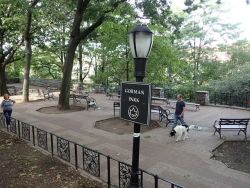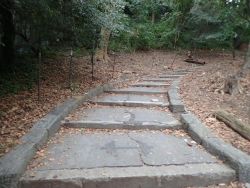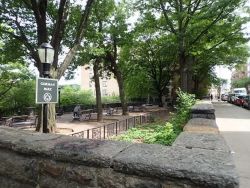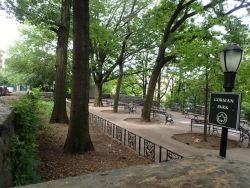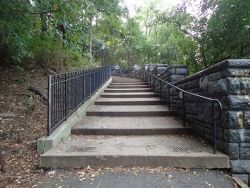Amelia Gorman Park
Gorman Park
This park, situated on a very steep hill rising from Broadway to Wadsworth Terrace, between West 189th and West 190th Streets, honors Gertie Amelia Gorman (1859-1920), a real estate investor. It was named at the request of her daughter, Gertie Emily Webb, whose husband, Charles Webb, carried out his wife’s wishes after her death. Webb, the chairman of a prestigious real estate company, donated $25,000 on June 28, 1929 towards the construction of the park and $50,000 to establish a trust fund for its maintenance. The City of New York acquired this property in 1929 as a gift from Charles Webb and the Denton Realty Corporation. Parks acquired jurisdiction over the property the following year.
Gorman Park is in Washington Heights, a neighborhood bounded by Dyckman Street, the Harlem River, 155th Street, and the Hudson River. Because of its strategic position along the Hudson, the area housed several Colonial forts during the Revolutionary period, including the neighborhood’s namesake, Fort Washington. The British Army captured Fort Washington, along with Fort Tryon, Cockhill Fort, and Fort George in 1776, and held it until the Continental Army prevailed, winning the war in 1783.
Washington Heights was farmland until the mid-19th century, when wealthy New Yorkers started settling here, drawn by the breathtaking views of the Hudson River. In 1889, the Washington Bridge over the Harlem River was completed, linking Manhattan and the Bronx. The area was still largely rural in 1904, when the Broadway subway line was extended through its southern portion, and subsequently through its northern portion, in 1906. With improved transportation, the neighborhood grew exponentially. Several institutions were built during this time, including the Columbia-Presbyterian Medical Center, Audubon Terrace, Yeshiva University, and the Polo Grounds stadium.
In 1931, the George Washington Bridge became the first and only bridge over the Hudson River to connect New York City and New Jersey. The following year, the City opened the Eighth Avenue subway, on the west side of the neighborhood, to serve the growing population.
During the 1980s, Washington Heights attracted the largest number of immigrants of any neighborhood in New York City. By 1990, the neighborhood’s Dominican community was the largest in the United States. In 1991, City Council Member Guillermo Linares became the first American of Dominican ancestry to be elected to political office in the United States.
The terrace-like park features numerous sitting areas, a wide, descending stone staircase that leads to Broadway, and walking paths. Gorman Park also contains a stone wall with an inscription dedicating the park to the memory of Gertie A. Gorman. In 2000, Council Member Guillermo Linares allocated $980,000 towards a reconstruction and landscaping of Gorman Park that began in the summer of 2001.
Check out your park's Vital Signs
Clean & Safe
Green & Resilient
Empowered & Engaged Users
Share your feedback or learn more about how this park is part of a
Vital Park System

